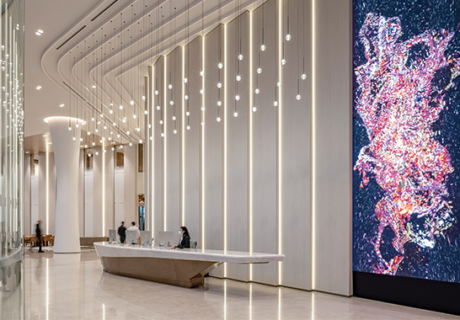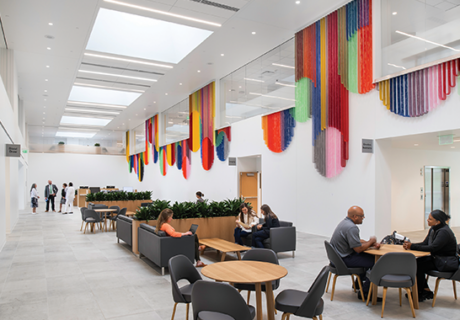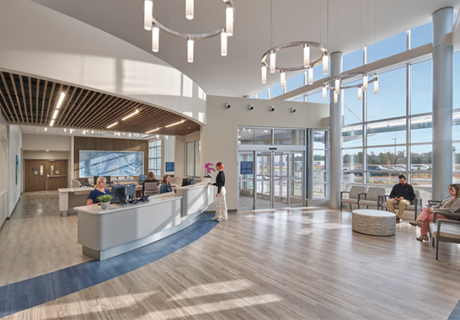Magic Moment: Centre hospitalier de l’Université de Montréal
The story of Quebec’s Centre hospitalier de l’Université de Montréal (CHUM), a new 3 million-square-foot academic medical center that opened in September, began more than 20 years ago when three of Montreal’s oldest healthcare institutions—Hotel-Dieu de Montreal (1861), Notre-Dame (1924), and Saint-Luc (1928)—decided to merge into one organization but maintain their existing facilities. While the effort helped address cost, efficiency, and care delivery via a regionalized health system, it didn’t solve the problem of antiquated infrastructure and facilities. In 1999, CHUM leaders decided to build a “super hospital” that would bring all three institutions under one roof in downtown Montreal.
Expectations were high, with program requirements calling for 442 exam rooms, 39 operating rooms, and 772 private patient rooms; accommodations for more than 10,000 employees and 6,000 medical students and interns; and the ability to serve 345,000 ambulatory patients, 22,000 inpatients, and 65,000 emergency patients annually.
The owner’s initial plan called for phasing the project in two parts, bringing one-half of the beds and one-half of the ORs online in Phase 1 and the rest in Phase 2. While this solution addressed some inherent challenges—including the fact that Saint-Luc hospital was located on the site where the new facility would be built and had to be kept operational during Phase 1 before being demolished to accommodate Phase 2—it led to a host of inefficiencies.
At the top of that list was that the approach resulted in building three bed towers spread over two city blocks, each with long corridors, disconnected departments, and duplicated infrastructure. It also drove up the project budget, with $1 billion alone tied up in financing fees and related costs associated with constructing the project over a multiple-year timespan.
CannonDesign (Chicago) and NEUF Architect(e)s (Montreal), one of the architecture/interior design firm partnerships competing for the project, spent 14 months meeting with the client and working on design proposals that would accommodate the phased plan, before coming to the realization that the approach was creating far more cons than pros, says Azad Chichmanian, partner and architect with NEUF Architect(e)s.
So, in July 2010, with the deadline to submit its design proposal only three months away, the team decided to ask the owner a question that ultimately changed the entire course of the project: If they were to approach the site again, knowing what they knew then, would they still split the project in half? The design team’s instinct was right; CHUM leaders said they would want everything on day one. “That’s the magic moment in the life of this project,” Chichmanian says.
The project team got a two-month extension on its deadline and began redesigning the overall building layout, regrouping departments, and optimizing adjacencies and operations. Then, by turning a proposed ambulatory building 90 degrees on the site and cutting it in behind Saint-Luc, relocating the emergency entrance, and maximizing every square inch of the first phase, the designers realized they could go from delivering only 55 percent of the program on day one to 85 percent. “Everything came together at that point,” Chichmanian says. And it won the team the project.
The CHUM opened in September with three buildings: the hospital with a diagnostic and treatment podium and two bed towers with all 772 beds; the ambulatory clinic building; and a logistics tower housing laboratories and pharmacy services. Phase 2, which is scheduled to be completed in 2021, will add an office building and 500-seat amphitheater with a conference center for medical education and an outdoor plaza.
“By doing this, we allowed not only a better planned hospital that’s more efficient … but also, we were able to accelerate and put online very needed clinical facilities,” Chichmanian says. “That’s years ahead of the schedule that the CHUM had planned. For Quebec, that’s extremely significant.”
Defining and refining
At 3 million square feet, the CHUM represents one of the largest healthcare construction projects in North America, with 15 inpatient departments and 40 specialty outpatient clinics that had to be planned and designed across five buildings on the new campus—from emergency, imaging, and surgery to a mother/baby unit, blood bank, and one of the largest radiation oncology treatment centers in Canada.
The project was structured as a public-private partnership (P3), with construction management and general contracting services delivered through a joint venture between Obrascón Huarte Lain (Madrid, Spain) and Laing O’Rourke (London), along with CannonDesign and NEUF Architect(e)s as architect/interior designer.
One of the first things the P3 team did to ensure the project stayed on schedule was establish a set of five guiding principles to help prioritize goals, including putting the patient first, creating a scale that’s accessible to patients and visitors, establishing a new identity for the three existing institutions, respecting the urban context, and building a master plan. These guidelines were always presented at the beginning of meetings as a reminder that patients were at the heart of every decision.
“When you’re designing a hospital and you’re in the middle of a traffic and logistics meeting and someone wants to put the front door to the garage next to emergency, which is going to potentially impact the clarity of access to the entrance, it becomes very important to remember what’s most important for the patient,” Chichmanian says.
Another planning priority was ensuring future flexibility and designing for the long term—an effort that proved invaluable after construction began in December 2013. For example, following the 2014 Ebola outbreak, CHUM leaders realized they hadn’t planned to handle such severely acute cases in the new facility. “One of the things that came out of that was a change directive from the CHUM for a new level of care rooms, called intermediate care,” says Christine Cavataio, senior vice president at CannonDesign (Montreal), who served as senior project manager for the CHUM.
Since the patient rooms are arranged on a standardized grid with universal design features, several rooms on three floors could be quickly converted for this purpose. Similarly, the ambulatory building houses exam rooms as well as individual consultation rooms, but the design team established the same general footprint for both so that as healthcare needs evolve over time, the use of these rooms can flex to meet specific departmental demands.
Creating an urban context
While the CHUM’s programmatic requirements provided an opportunity to rethink operational planning on a large scale, its urban setting was a chance to redefine healthcare in the city and create a new landmark. The hospital is on two blocks in a neighborhood that was once a social hub for the city’s French population until a highway was built in the early 1970s, dividing the community and creating a sense of isolation. The city viewed the CHUM project as a catalyst for urban renewal and an opportunity to reconnect the area by anchoring a new health district, Quartier de la Santé, which includes a neighboring research center.
Another benefit of organizing the facility into five buildings was to better fit the massive structure into the existing neighborhood. On the street level, an “open and transparent” strategy was employed to appeal to the pedestrian setting and welcome patients and families with street-level building forms kept in scale with the low- and mid-rise structures nearby.
The main entrance of the campus features a large inner courtyard, the Esplanade Jardin, with copper cladding planned for the Phase 2 amphitheater inspiring visual references throughout the pedestrian circulation paths to aid wayfinding.
Furthermore, the project team committed to preserving a series of architectural elements already on the site, including a church built in 1865 and the church custodian’s house built in 1871. The church steeple and two walls from the house were disassembled and then integrated into the new hospital, with the steeple becoming one of the main entrances that connects to an outdoor eating area on the second floor and the house walls displayed in glass inside the public atrium.
The historic elements are juxtaposed with a modern materials palette, including glass, aluminum, copper, and stone. “All these elements animate the pedestrian experience and re-stitch part of that urban fabric together,” Chichmanian says.
Another striking piece of architecture at the CHUM is the elevated “passerelle,” or bridge, connecting the ambulatory center to the logistics building. The link wasn’t part of the original proposal, in part because the city of Montreal doesn’t promote above-ground connections over public streets. Instead, the project team planned to link the buildings solely via an underground passageway before deciding to create a more efficient and direct connection between the blood bank and the surgery block across the street.
“The city set the bar high in that if they were going to allow us to have this aerial connection, it would have to be almost an art piece,” Chichmanian says.
The result is an organic-shaped structure covered in perforated copper panels (also inspired by the planned copper-clad amphitheater), which allow sunlight to pass through without casting shadows below, while at night the illuminated bridge appears as a lantern. Staff use the elevated passageway to move between the buildings, and the underground tunnel is used for logistics flow.
Inside the CHUM, the interior design strategy is focused on humanizing the environment and helping patients, families, and visitors navigate the structure. Color is a primary wayfinding tool, with each floor of the outpatient clinic assigned a specific color, while the inpatient side features three alternating hues. Warmer tones are used in the north tower and cooler ones in the south tower, each balanced with the availability of natural light in those spaces.
“Color is located in key points where people need to go and know they’ve arrived at a point of destination,” says Jocelyn Stroupe, director of healthcare interiors for CannonDesign.
There’s also an interplay of color between the interior and exterior. For example, the outpatient building has an expansive glass curtainwall that allows the colorful clinic entrances to be seen from outside. The building façade also features one of several art pieces commissioned for the project per Quebec law, which requires 1 percent of a project’s construction budget to be spent on public art.
An art committee curated a program of more than 13 large-scale works, the largest of which, titled “La vie en montagne” (“Mountain Life”), spans eight stories on the ambulatory building. It comprises five medallions printed with images of mountain peaks that, when viewed up close from inside one of the clinic waiting rooms, reveal a mosaic of inspiring words to provide patients with a multilayered positive distraction.
Taken together, these details illustrate the project’s focus not only on what’s happening inside the healthcare facility, but also on how the community views the building and interacts with its new healthcare neighbor. “You feel a vibrancy when you walk the patient floors,” Cavataio says. “It’s night and day between the old facilities and the new CHUM.”
Anne DiNardo is executive editor of Healthcare Design. She can be reached at ANNE.DINARDO@EMERALDEXPO.COM.
Project Summary:
Completion date: Fall 2017 (Phase 1); fall 2021 (Phase 2)
Owner: Centre hospitalier de l’Université de Montréal (CHUM)
Total building area: 3 million sq. ft.
Total construction cost: $2 billion
Cost/sq. ft.: $391
Architecture: CannonDesign + NEUF Architect(e)s
Interior design: CannonDesign + NEUF Architect(e)s
Engineering: HH Angus
Construction manager/general contractor: Obrascón Huarte Lain, Laing O’Rourke
Flooring: Ceragres, Gerflor, Nora, Altro, VPI, Mondo, Roppe, Stonhard, Sikafloor, Franklin Precast Terrazzo
Ceiling/wall systems: Armstrong, Precision Air Products, Decoustics, Panolam, Trespa, Lexan, Cavritec
Doors/locks/hardware: Allegion, Besam, Baillargeon, Lambton
Fabric/textiles: Inpro Corp. (cubical)
Furniture—seating/casegoods: Groupe Lacasse, Global Furniture Group
Handrails/wall guards: CS Acrovyn, Inpro Corp., Gerflor, Altro, Marlite, Panolam
Headwalls/booms: Amico
Wallcladding: Dramex
Surfaces—solid/other: Formica, Wilsonart, Nevamar, Abet Laminati, Corian, Durcon
Wallcoverings: Benjamin Moore, Sherwin Williams, Dulux, Wolf Gordon, Sico
Shading System: Mechoshade
Lighting: Lumen Pulse
Metals: Waverly Metals
Glass: Chronoglass
















